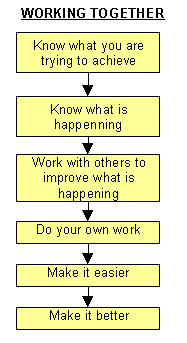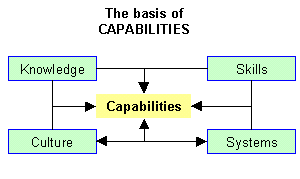![]()
Other topics
Schools are about people. When people work well together the costs are reduced and productivity increased. When people do not work well together the opposite outcomes result.

1. Know what you are trying to achieve by working together. The most common stumbling block in working together is lack of clarity regarding what is to be achieved. What are the desired outcomes and hence the required processes and outputs
Someone once said that the goals of education are ambiguous, the technology uncertain and participation is fluid. This same person then drew the conclusion that education is 'organised anarchy'.
Working together means working with people. It is necessary to take into consideration what each person is trying to achieve in order to be able to work together. Not easy - but our best teachers are master practitioners of this craft. The alternative is to work on people - a sad imitation of education.
Being clear about our own aims and purposes is the starting point for working with others to achieve the agreements on the basis of which we can work together. The power imbalances and conflicting between systems, schools, staff, students and their families often tempt us to skip this step. Consider the agreements that Riverside Primary School has in place across its whole school community. Can you how these agreements support everyone working together.
2. Know what is happening
The reason that quality management has put such an
emphasis on data is that good, bad or indifferent, reality is always the safest
basis on which the choose one's actions. Ignorance is a great source of
disruption, waste, rework and anxiety. Ultimately lack of knowledge of what is
happening will rob students of teaching time.
Knowledge about what is happening is technically known as 'in-process' data
and it helps those involved manage the processes with which they are involved,
ie, Information also makes people much more responsible than policy. This
knowledge includes
who is doing
what with what
resources
how and what the
outcomes are at any point in
time.
It is for this reason that quality
management invests in knowledge of systems, processes
3. Work with others to
improve what
is happening.
No one has the whole story. No one has such insight & 'control' that
they can single handedly design and improve the
school . The day to day tasks, and the variables, involved in the life and work
of a school are too complex and many critical factors are unknown.
4. Do your own work well.
If the school system is well designed people will
know how to make their contributions easily and well.
Purposes, processes, responsibility
discretion will all be clear.
Responsibility for tasks will not necessarily be isolated which is contrary to a common piece of management 'wisdom'.
With the right knowledge,
skills, systems and culture responsibility can be well shared. People
(especially those in teams)
who are confident and competent and committed can be trusted to share a (team) responsibility (see
leadership). While roles will
be well understood people will have good working relationships that will provide
the flexibility that means that the best person to do a task is the person who
does it. This will depend on knowledge, skills, relationships, availability
...
5. Make it easier
for
the next person (and yourself too - in a complex task most of the time you are
the next person). Making it easier for everyone (especially the next
person) is the critical improvement to aim for because
it
- releases resources
- increases 'throughput'
- reduces the 'unfinished' work in the
system
- puts an increased value on the people and their tasks
- makes one a contributor (which is the
critical test for belonging)
All of which reduces cost & stress and increases the
opportunities for people to do well and have fun.
Make it better
People want to do a good job unless they are discouraged, eg,
they feel undervalued by those they serve
they feel the work is not important
they are confused about what is to be achieved and how
they feel incompetent (a core danger of quotas, targets, ...)
and so on ...Well designed systems
consider both people & tasks
have clear purposes & processes and adequate resources...
and so they naturally improve as people work together to complete their tasks easily & well.
 How people work together is a matter of capability
and behaviour. And both are influenced by
How people work together is a matter of capability
and behaviour. And both are influenced by
knowledge
skills
systems, and
culture (of the family, community school...)
To create a situation in which people work well together it is necessary people to have insights into their own situation and behaviour.
Teachers & leaders can apply 'mediated learning' to achieve these insights and ensure that the school and its people have the knowledge, skills, systems & culture to make it easier for people to work well together.
--> Easier First
![]()